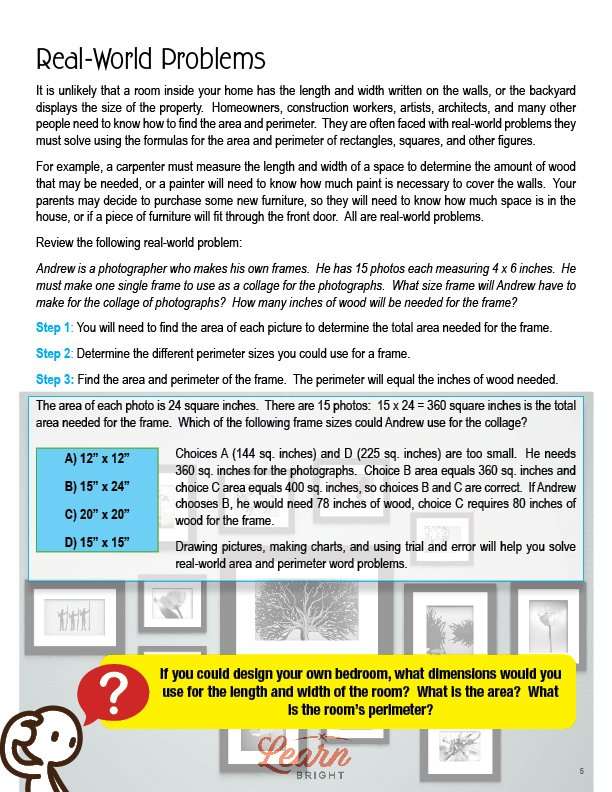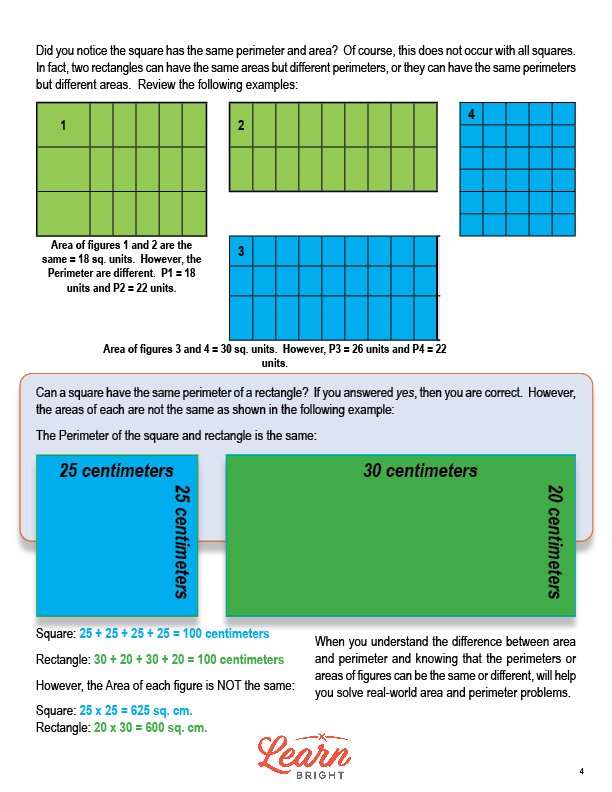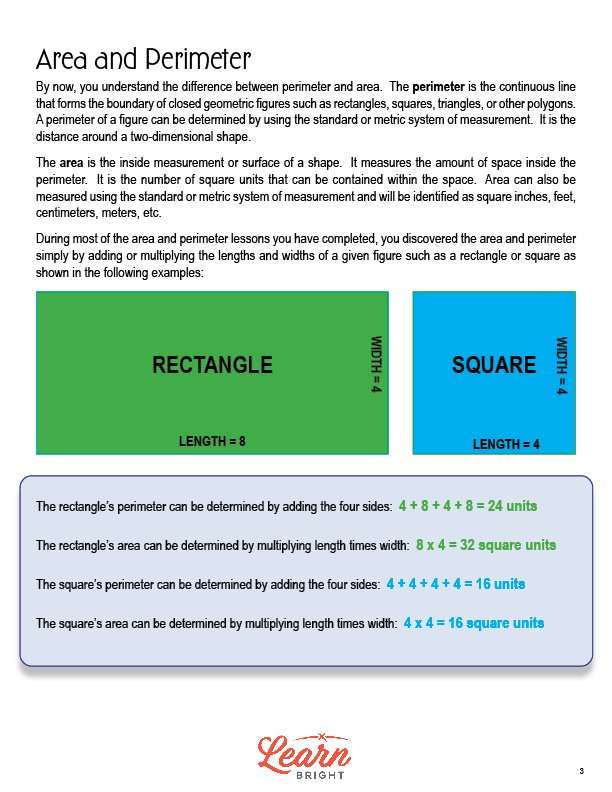Description
What our Area and Perimeter Word Problems lesson plan includes
Lesson Objectives and Overview: Area and Perimeter Word Problems teaches students strategies for solving word problems that include area and perimeter. At the end of the lesson, students will be able to solve real-world and mathematical problems involving perimeters of polygons, find unknown sides, and recognize rectangles with different perimeters/areas. This lesson is for students in 3rd grade and 4th grade.
Classroom Procedure
Every lesson plan provides you with a classroom procedure page that outlines a step-by-step guide to follow. You do not have to follow the guide exactly. The guide helps you organize the lesson and details when to hand out worksheets. It also lists information in the blue box that you might find useful. You will find the lesson objectives, state standards, and number of class sessions the lesson should take to complete in this area. In addition, it describes the supplies you will need as well as what and how you need to prepare beforehand. The supplies you will need for this lesson are scissors and the handouts. To prepare for this lesson ahead of time, you can gather the supplies and copy the handouts.
Options for Lesson
Included with this lesson is an “Options for Lesson” section that lists a number of suggestions for activities to add to the lesson or substitutions for the ones already in the lesson. An optional addition to the lesson activity is to have students write down the sizes of the rectangles and squares. Another addition to the lesson is to have students use your classroom or school to create real-world word problems. You could also invite a carpenter or other professional to come speak to your class about how they use area and perimeter in their jobs. Finally, you could have students design their perfect bedroom, complete with measurements!
Teacher Notes
The teacher notes page includes a paragraph with additional guidelines and things to think about as you begin to plan your lesson. This page also includes lines that you can use to add your own notes as you’re preparing for this lesson.
AREA AND PERIMETER WORD PROBLEMS LESSON PLAN CONTENT PAGES
Area and Perimeter
The Area and Perimeter lesson plan includes three content pages. The lesson begins by reminding students what the differences between area and perimeter are. Perimeter is the continuous line around the boundary of closed geometric figures like rectangles, squares, triangles, and other polygons. We can determine perimeter by using the standard or metric systems of measurement. On the other hand, area is the inside measurement of a surface or shape (the amount of space inside the perimeter). It’s the number of square units that can fit inside a contained space. Like perimeter, we can also measure it using the standard or metric systems of measurement.
Previously, students have likely learned how to find area and perimeter by simply adding or multiplying the lengths and widths of shapes like squares and rectangles. The lesson includes a few examples of this, with solutions. In the example, the square has the same area and perimeter. This is not always true! Also, two rectangles that have the same area can have different perimeters and vice versa. A square can also have the same perimeter as a rectangle, though their areas will be different. The lesson shows examples of both of these scenarios.
Understanding the difference between area and perimeter, as well as how to find them, will help you solve real-world area and perimeter problems!
Real-World Problems
Many people work with area and perimeter every day! Homeowners, construction workers, architects, artists, and more need to know how to find area and perimeter to do their jobs. They must deal with real-world problems that require them to find the area and perimeter of rectangles, squares, and other shapes. Carpenters, for example, might need to measure a space to find out how much wood they’ll need for a project. A painter needs to know how large the walls in a room are so they know how much paint they’ll need.
The lesson then includes a real-world problem as an example. The problem states that a photographer has 15 photos of a certain size and that he needs to make one frame for a collage. Students will determine what size frame he will need to make and how much wood will be needed for the frame. The lesson breaks this down into three steps. The first step is to find the area of each picture to find the total area needed for the frame. The second step is to determine the different perimeter sizes that he could use for the frame. Finally, the third step is to find the area and perimeter of the frame (which is the same measurement as the inches of wood needed for the frame). The lesson then shows students how to solve the problem.
AREA AND PERIMETER WORD PROBLEMS LESSON PLAN WORKSHEETS
The Area and Perimeter lesson plan includes three worksheets: an activity worksheet, a practice worksheet, and a homework assignment. You can refer to the guide on the classroom procedure page to determine when to hand out each worksheet.
CREATE A REAL-WORLD PROBLEM ACTIVITY WORKSHEET
Students will work with a partner to complete this activity. They will begin by cutting out the provided squares. They’ll use these squares to create rectangles with different perimeters but the same areas, squares and rectangles with the same or different areas and perimeters, and rectangles with the same perimeters but different areas.
They will then create a Real-World Word Problem for another pair of students to solve. They’ll write their problem in the space provided on the worksheet, and the answer to the problem in the second empty space on the worksheet. They will then cut both the question and answer key out and will write their names on the backs of each.
Students can work either alone or in groups for this activity if you’d prefer.
ANSWER THE QUESTIONS PRACTICE WORKSHEET
For the practice worksheet, students are asked to answer ten questions related to the lesson material. Questions include “What is the perimeter of a square that measures 5 feet by 5 feet?” and “True or False: Two rectangles can have the same area but different perimeters.”
AREA AND PERIMETER WORD PROBLEMS HOMEWORK ASSIGNMENT
The homework assignment asks students to solve five word problems, drawing pictures if necessary.
Worksheet Answer Keys
This lesson plan includes answer keys for the practice worksheet and the homework assignment. If you choose to administer the lesson pages to your students via PDF, you will need to save a new file that omits these pages. Otherwise, you can simply print out the applicable pages and keep these as reference for yourself when grading assignments.










